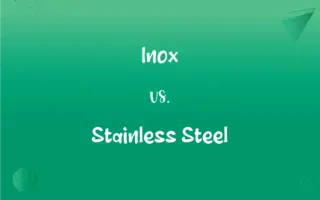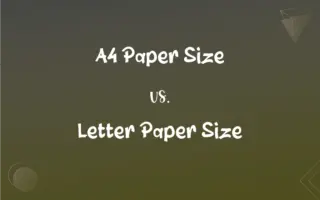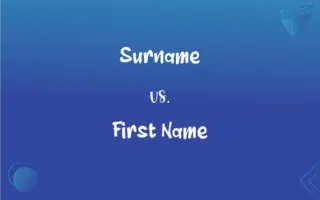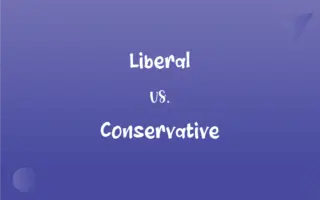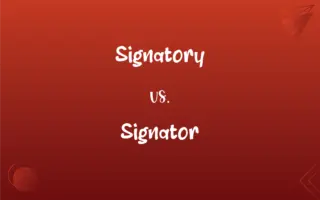Anaphora vs. Cataphora: What's the Difference?
Edited by Aimie Carlson || By Janet White || Published on October 13, 2023
Anaphora is the use of a word referring to or replacing a word used earlier in a sentence to avoid repetition, such as "do" in "I like it and so do they", while Cataphora is the reference to a word or phrase that appears later in the text, used for emphas

Key Differences
Anaphora and Cataphora are linguistic terms describing the reference of a word or phrase to another word or phrase in a text. Anaphora involves a word that refers back to a word or phrase that has already been mentioned in a discourse. It prevents redundancy and usually aids in maintaining cohesiveness within the text. On the other hand, Cataphora refers to a word that is clarified or defined by a subsequent word or phrase within the discourse. It often creates a sense of anticipation and places emphasis on the forthcoming referent.
In the structure of a sentence or text, Anaphora comes after the antecedent, the word or phrase to which it refers. It connects ideas and can lend a sense of rhythm and continuity to a piece of writing. In contrast, Cataphora precedes the postcedent, the word or phrase that gives it definition or clarification. It may be used for stylistic effect, often creating a slight pause in understanding until the reader encounters the clarifying term.
A practical example of Anaphora could be, "David loves music; he attends concerts every month." In this sentence, "he" is an anaphoric reference to "David". A Cataphora example could be, "If you need it, the ladder is in the garage," where "it" is a cataphoric reference to "the ladder". These concepts highlight the flexibility and dynamics inherent in language structure and use.
Anaphora is generally more common and recognizable, especially in English language writing and rhetoric, and is often utilized to create a sense of rhythm and emphasis. Cataphora, while less frequent, offers a unique stylistic approach, allowing authors to play with expectation and revelation within their writing, shaping the reader’s experience and interaction with the text.
In sum, while Anaphora and Cataphora serve similar referential functions in linguistics, they operate in opposing directions within the text. Anaphora looks back to an already mentioned word or phrase, offering clarity and cohesion, while Cataphora looks forward to a yet-to-be-mentioned word or phrase, providing emphasis and stylistic intrigue.
ADVERTISEMENT
Comparison Chart
Direction of Reference
Refers back to a previously mentioned word or phrase
Refers forward to a word or phrase mentioned later
Position
Follows the antecedent
Precedes the postcedent
Frequency in Usage
More common
Less common
Effect in Text
Provides clarity and cohesion
Creates anticipation and emphasis
Relation to Referent
Comes after the word or phrase it refers to (antecedent)
Comes before the word or phrase it refers to (postcedent)
ADVERTISEMENT
Anaphora and Cataphora Definitions
Anaphora
Anaphora is a rhetorical device that features the repetition of a word or phrase at the beginning of successive clauses or sentences.
To raise a happy, healthy, and hopeful child, it takes a family; it takes teachers; it takes clergy; it takes business people; it takes community leaders; it takes those who protect our health and safety; it takes all of us. – Hillary Clinton
Cataphora
Cataphora is a figure of speech where a pronoun or pro-word refers to a word or phrase that is mentioned later in the text.
If you need one, there's a hammer in the toolbox.
Anaphora
In linguistics, anaphora refers to the use of pronouns and other words to avoid redundancy, referencing back to previously mentioned words.
David enjoyed the concert. He said the music was fantastic.
Cataphora
In linguistics, cataphora involves the use of words to refer forward to a word or phrase that appears later.
When he arrived, John noticed that the room was in total chaos.
Anaphora
Anaphora serves to establish a clear connection between sentences or clauses in discourse.
The weather was great, and we made the most of it.
Cataphora
Cataphora creates a pause in understanding until the reader encounters the clarifying term.
If they are too tight, the shoes might cause discomfort.
Anaphora
Anaphora can create a rhythm and emphasize a particular point through repetition.
With malice toward none; with charity for all; with firmness in the right.
Cataphora
Cataphora can be used stylistically to delay the revelation of the identity of the referent.
If you’re looking for it, the key is under the mat.
Anaphora
The deliberate repetition of a word or phrase at the beginning of several successive verses, clauses, or paragraphs; for example, "We shall fight on the beaches, we shall fight on the landing grounds, we shall fight in the fields and in the streets, we shall fight in the hills" (Winston S. Churchill).
Cataphora
Cataphora is used for emphasis and to create anticipation by placing the referent after the pronoun.
If it bothers you, the noise can be reduced by closing the window.
Anaphora
(Linguistics) The use of a linguistic unit, such as a pronoun, to refer to the same person or object as another unit, usually a noun. The use of her to refer to the person named by Anne in the sentence Anne asked Edward to pass her the salt is an example of anaphora.
Cataphora
The use of a linguistic unit, such as a pronoun, to refer ahead to another unit, for example, the use of him to refer to John in the sentence Near him, John saw a snake.
Anaphora
(rhetoric) The repetition of a phrase at the beginning of phrases, sentences, or verses, used for emphasis.
They didn't speak. They didn't stand. They didn't even look up when I came in.
Cataphora
The use of a pronoun, or other linguistic unit, before the noun phrase to which it refers, sometimes used for rhetorical effect.
Anaphora
(linguistics) An expression that can refer to virtually any referent, the specific referent being defined by context.
Anaphora
(linguistics) An expression that refers to a preceding expression.
Anaphora
(Christianity) The most solemn part of the Divine Liturgy or the Mass during which the offerings of bread and wine are consecrated as body and blood of Christ
Anaphora
Plural of anaphor
Anaphora
A repetition of a word or of words at the beginning of two or more successive clauses.
Anaphora
The use of a substitute word, such as a pronoun, in reference to a something already mentioned in a discourse; also, the relation between the substitute word and its antecedent. It is contrasted with cataphora, the use of a pronoun for a word or topic not yet mentioned.
Anaphora
Using a pronoun or other pro-word instead of repeating a word
Anaphora
Repetition of a word or phrase as the beginning of successive clauses
Anaphora
Anaphora is a figure of speech where successive phrases or lines begin with the same words.
“I have a dream” is an example of anaphora in Martin Luther King Jr.’s speech.
FAQs
Can anaphora create a sense of rhythm in writing?
Yes, anaphora can create rhythm and emphasize a point through repetition.
Is anaphora solely a literary device?
No, anaphora also serves linguistic purposes, providing cohesion by referencing previous words.
Are anaphora and cataphora common in everyday speech?
Anaphora is relatively common, while cataphora is less frequent and more stylistic.
What is the primary difference between anaphora and cataphora?
Anaphora refers back to a previously mentioned word, while cataphora refers forward to a word mentioned later.
Can cataphora be used for stylistic purposes in writing?
Absolutely, cataphora can be stylistic, delaying the revelation of the referent.
Can anaphora refer to words or phrases?
Yes, anaphora can refer to both words and phrases that have been previously mentioned.
Does cataphora create anticipation in the reader?
Yes, cataphora can create anticipation and emphasize the referent.
Does cataphora always precede its referent in text?
Yes, cataphora precedes the word or phrase to which it refers, the postcedent.
Can anaphora be unintentional in spontaneous speech?
Yes, people may unconsciously use anaphora in speech for clarity and cohesion.
Does the use of cataphora impact the flow of a text?
Yes, cataphora can impact the flow by creating a pause in understanding.
Is the use of anaphora and cataphora restricted to the English language?
No, the concepts of anaphora and cataphora exist in many languages.
Is the use of cataphora limited to pronouns?
No, while common with pronouns, cataphora can also involve other pro-words or phrases.
Is cataphora more common in specific types of writing?
Cataphora is often found in more creative or literary writing due to its stylistic nature.
Can anaphora be used in political speeches for emphasis?
Definitely, anaphora is often used in political speeches to emphasize certain points.
Are anaphora and cataphora examples of pronoun reference?
Yes, they are both specific types of pronoun reference, differing in the direction of the reference.
About Author
Written by
Janet WhiteJanet White has been an esteemed writer and blogger for Difference Wiki. Holding a Master's degree in Science and Medical Journalism from the prestigious Boston University, she has consistently demonstrated her expertise and passion for her field. When she's not immersed in her work, Janet relishes her time exercising, delving into a good book, and cherishing moments with friends and family.
Edited by
Aimie CarlsonAimie Carlson, holding a master's degree in English literature, is a fervent English language enthusiast. She lends her writing talents to Difference Wiki, a prominent website that specializes in comparisons, offering readers insightful analyses that both captivate and inform.





